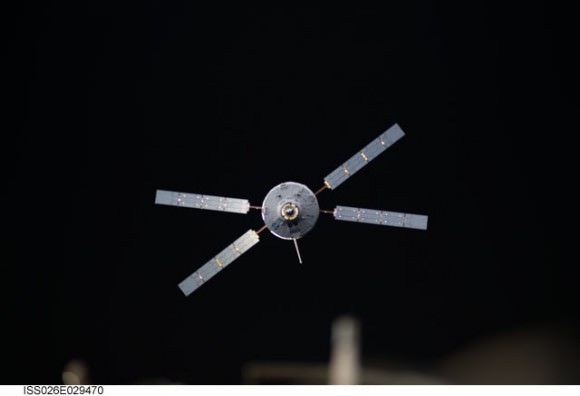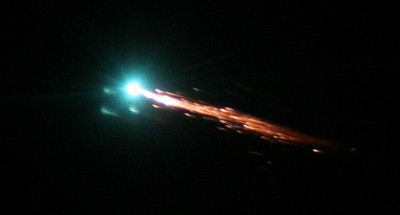[/caption]
The Johannes Kepler ATV (Automated Transfer Vehicle) has undocked from the International Space station and will re- enter Earth’s atmosphere on June 21st ending its mission in fiery destruction.
The ATV has been docked with the ISS since February, where it delivered supplies, acted as a giant waste disposal and boosted the orbit of the International Space Station with its engines.
The X-wing ATV delivered approximately 7 tonnes of supplies to the station and will be leaving with 1,200kg of waste bags, including unwanted hardware.

On June 21st at 17:07 GMT the craft will fire its engines and begin its suicide mission, tumbling and burning up as a bright manmade fireball over the Pacific Ocean. Any leftover debris will strike the surface of the Pacific ocean at 20:50 GMT.
During the ATV’s re-entry and destruction there will be a prototype onboard flight recorder (Black Box) transmitting data to Iridium satellites, as some aspects of a controlled destructive entry are still not well known.
ESA says that this area is used for controlled reentries of spacecraft because it is uninhabited and outside shipping lanes and airplane routes. Extensive analysis by ESA specialists will ensure that the trajectory stays within safe limits.
There still are some chances to see the ISS and Johannes Kepler ATV passing over tonight, but if you in a location where you can see the south Pacific skies starting at about 20:00 GMT, keep an eye out for a glorious manmade fireball.



Seems a serious waste of money to throw away a perfectly good man-rated spacecraft that might have become a module on the space station with a little forethought. Using the ATV as a multi-million dollar garbage can fritters away all the energy it took to get it into orbit.
They have to get rid of the garbage somehow…
How about a bag made of some special space age fiber?
How would you make a controlled re-entry with such a bag?
It hardly has to be a ‘special’ material, or make a controlled re-entry…but it *does* have to have enough guidance and propulsion to make the de-orbit burn…
Firstly, I never stated that it has to be made of a ‘special’ material. Secondly, your statement, “it *does* have to have enough guidance and propulsion to make the de-orbit burn”, sounds like a controlled re-entry to me.
No you didn’t, that was for Michael Brady’s reference.
I took ‘controlled’ (as opposed to ‘destructive) re-entry, as one meant to be survived…
Perhaps I should have been more specific… what I had meant by “controlled re-entry” was one directed over an unpopulated area, such as the Pacific.
maybe a solar sail and a very (VERY) small rocket engine for a final burn could be enough for +-1000 km target area.
See my “Update” comment above.
How would you make a controlled re-entry with such a bag?
I suggest better moderators. Get a handle on all that ISS EU Riff-Raff!
PS: …should I be capitalizing “riff-raff”??
That depends on How Important The Riff-Raff Is For A Clean Conscience. (Or sumthin’ like that.)
Er… the definition of “riff-raff” is any particular group of people regarded as disreputable or worthless; therefore, they are not worthy of capitalization.
“Mini Space Station
The MSS concept is an ATV evolution proposal for the construction of multiple ATVs with two docking ports, one at each end. The current version of the ATV is already prepared for a docking port at the back, with the main propulsion system arranged in a cylindrical fashion leaving room for a tunnel through the middle. This concept would allow Soyuz, Progress and other ATVs to dock to the back of the ATV, allowing a steady flow of Russian vehicles using the available docking ports whilst an ATV is docked for an average of around 6 months at a time.” [Wikipedia]
The lack of ports (whether ATV or ISS) and, presumably, the lack of other means to return larger masses of waste is what keeping the ATV to more mundane tasks I believe.
Thanks Torbjörn, I’m mostly musing on missed opportunities. Building the ISS using (or making more efficient use of) automated delivery vehicles would have to have been implemented in the conceptual stage of the program (back when they were deciding how big to make the “loading dock”). In those days NASA still thought the STS would be both cost effective and safe, so it made more sense to build it using the shuttle (or was it the other way round?)
I’m sure we can all relate.
But in my experience (and, I believe, project mishap reports) a “serious waste of money” usually has its explanations. More generally, if just about everything R&D has ROI, any money that goes to ice cream is a “serious waste”. :-/
The missed opportunities scheme (bad choice of how much and what to use R&D money for) is a much better line of questioning IMO.
As for burning up the trash in re-entry in a safe manner, encasing smaller pieces in an ATV only makes for a bigger meteoric body that if anything is More dangerous because of the greater possibility that it won’t burn up completely. The same effect could be achieved by using a trash compacter to form blocks of trash and deorbiting them. Then we could stockpile or utilize the ATVs as needed whether as habitat or spacecraft- they would be appropriate for either function.
ISS doesn’t need an infinite number of modules, but it does have a finite number of docking ports. (It would be like leaving a truck trailer attached to a building. You still have to have electrical/plumbing/HVAC connections to make it useful, and up to code. You may not even need the ‘extra room,’ but you *do* need that loading dock you’ve tied up indefinitely. It’s like notions of [somehow] collecting non-functioning satellites and other orbital debris, and doing something with them, as they’re already up there…not all on-orbit mass has value just because it’s on orbit. )
The ‘energy’ to get something into orbit is cheap. That’s not what makes spaceflight expensive.
And the trash still has to be returned or de-orbited in something, or become a hazard itself…
I totally agree! Congress gripes and moans about expenses, but yet is perfectly willing to use a fully man rated spacecraft as a garbage can to burn up trash in re-entry. We should be stockpiling everything that goes up there so that it can be used to expand our facilities in orbit. If they don’t want to add them to ISS as modules, they can be joined together into clusters and rotated around a common center to provide weighted living quarters in orbit. Or, combine a few of them with an engine and go to the moon and back…same with Mars, or an asteroid or moon if we use some form of ion drive. But they’ll probably keep throwing them away…just like grounding the shuttles- they could have left one on station at ISS, there’s nothing wrong with it so long as it’s used as a SPACEship, only if you use it for orbit and re-entry. If left on station, refueled and provisioned (possibly modified), a shuttle could easily be a Moon ship or Mars ship…but not sitting on Earth with schoolkids tramping through it as a museum. I’ll swear, some of our space policies seem more designed to keep us OUT of space exploration than the reverse.
Er… dude, the ATVs are developed by the European Space Agency (ESA), so it has nothing to do with the U.S. Congress.
I think all the garbage should be ‘shrink wrapped’ and then attached to a rocket to slow it down to de-orbit.